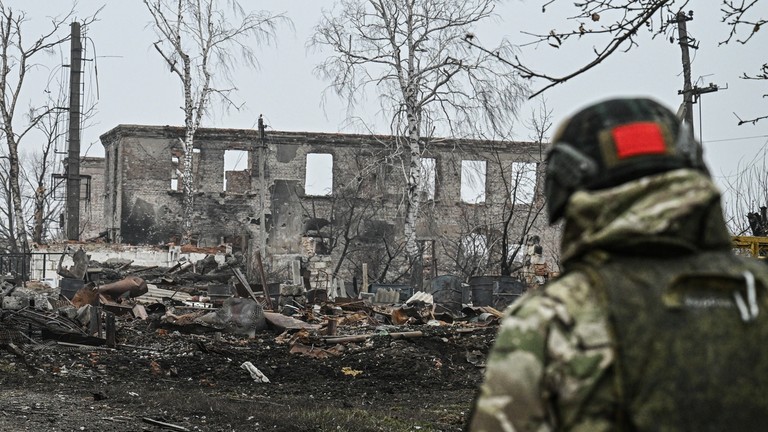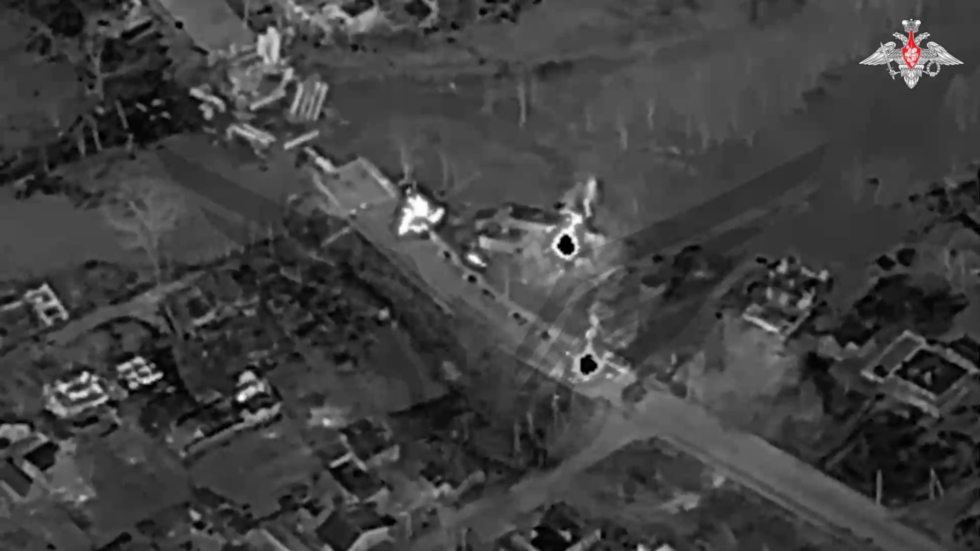©Sputnik/Stanislav Krasilnikov
The Russian Defense Ministry has announced the liberation of 12 villages across Kursk Region, reporting a rapid advance against Ukraine’s invasion force in the area.
Over the past 24 hours, Russian troops have recaptured more than 100 square kilometers of land, the ministry said in its daily briefing on Tuesday. The liberated locations named by the military include the villages of Agronom, Bogdanovka, Bondarevka, Dmitryukov, Zazulevka, Ivashkovsky, Kolmakov, Kubatkin, Martynovka, Mikhailovka, Pravda, and Yuzhny.
The development suggests that Russian troops are advancing on the town of Sudzha from the north, east, and southeast, while Ukrainian forces are apparently fleeing southwest across the river of the same name. According to media reports, Moscow’s forces have already entered the town, which remains the largest settlement in Kursk Region under Kiev’s control.
Over the past week, things have rapidly deteriorated for the Ukrainian force in Kursk Region, with its northern flank effectively collapsing. It remains unclear whether Kiev’s troops will try to make a stand in Sudzha or retreat altogether.
The invasion force has long been experiencing logistics troubles, as the Russian military has gradually been cutting off its supply routes. Now, the remnants of the Ukrainian force are dependent on a single major cross-border road, which has been coming under constant drone and artillery strikes.
Kiev invaded Kursk Region last August, capturing Sudzha and multiple villages in its vicinity in a matter of days. The Ukrainian zone of control, however, has gradually been shrinking ever since, with the invasion force now having lost more than two-thirds of its initial gains.
The attack on Kursk Region has taken an extreme toll on the Ukrainian military, with the invasion force reporting up to 66,550 casualties during the operation, the latest estimates by the Russian Defense Ministry suggest. Nearly 400 Ukrainian tanks, more than 300 infantry fighting vehicles (IFVs), 272 armored personnel carriers (APCs), and over 2,000 other armored vehicles were destroyed or captured in the hostilities in the area.
‘We burst out unexpectedly, like demons’: How Russia’s ‘pipeline operation’ crushed Ukrainian defenses in Kursk
The Russian army is conducting a major counteroffensive in Kursk Region, which was invaded by Ukrainian forces in August 2024. In just the past 24 hours, Russian troops have liberated 12 settlements and recaptured over 100 square kilometers of territory. This week, the industrial zone in Sudzha, the largest Russian city under the control of the Armed Forces of Ukraine (AFU), was also retaken.
Ukrainian forces are retreating. This was made clear by the AFU commander-in-chief, General Aleksandr Syrsky, who said that “units are taking timely measures to maneuver to favorable defense lines.”
The dramatic shift in the situation on the front can be attributed to the success of Russia’s top-secret Operation Potok (‘Flow’). A unit of 800 Russian soldiers walked several miles through an empty gas pipeline to infiltrate Ukrainian positions. Below are the details of this operation.
Preparing for the breakthrough
Prior to January 1, 2025, gas was transported from Russia to Europe via the Urengoy-Pomary-Uzhgorod pipeline, which passes through Ukrainian territory. Although Vladimir Zelensky halted gas transit, the pipeline remains. Russian fighters decided to utilize these pipes to secretly approach the fortified positions of the AFU near Sudzha.
Preparations for the operation took about four months. The mission itself started in early March and lasted just over a week. The primary goal was to conduct sabotage operations in enemy territory, compel Ukrainian forces to withdraw from occupied areas in Kursk and move toward Sudzha, where they would be met by Russian troops.
On March 1, oxygen tanks were delivered to the site of the operation. The following day, Russian soldiers entered the gas pipeline in small groups, and started moving toward Sudza.
This isn’t the first time that Russian troops have employed “pipeline tactics.” In January 2024, military scouts, along with the ‘Veterany’ unit, used an abandoned pipe to reach the rear positions of the AFU in a fortified area on the southern outskirts of Avdeevka in the Donetsk People’s Republic. Amid artillery and mortar shelling, which masked the sounds of the work, Russian troops cleared the two-kilometer-long (1.2-mile) passage and installed ventilation. This operation greatly helped Russian forces capture the Avdeevka fortress.
“This isn’t the first time they’ve used the pipes, that’s for sure. In Sudzha, they leveraged the experience gained from a previous mission in Avdeevka. From what I understand, some of the guys from the ‘Veterany’ unit who participated in the Avdeevka operation were also involved in [the operation in] Sudza,” says military blogger and volunteer of the Española Brigade, Alexey Zhivov.
However, this time, the situation was a lot more complex.
A week in the dark without oxygen
The soldiers spent several days in complete darkness, with limited access to fresh air. In such conditions, they had to navigate over 15 kilometers (more than 9 miles) through a 1.4-meter-wide (4.5-foot) pipe.
Numerous challenges arose during the operation. Although the pipe was wide, it wasn’t tall enough for the fighters to walk upright. Moreover, some leftover gas remained inside, so it was difficult to breathe. Engineering troops devised a ventilation system, drilling holes wherever possible to allow air to flow in.
Special protective gear was necessary to prevent poisoning. Carts were used to deliver water and other essentials. In an exclusive RT video, at 04:34, we can see a fighter showing one of these carts to reporters.
The soldiers moved in groups of five, maintaining a distance of about ten meters. When they paused, they spread out two meters from each other to breathe more comfortably.
“While they were looking for oxygen and preparing everything, many compromised their health. Our guys spent days hauling communications equipment, water, and living in that pipe,” military correspondents said about the operation.
The course of the operation
The entry into the pipe, conducted in small groups to avoid drawing the enemy’s attention and raising suspicions, stretched over four days.
It took several days to move through the pipe, and then the troops had to wait a few more days to receive orders for the assault. Near the exit points, special underground facilities were set up, and food, water, and ammunition supplies were stockpiled.
One of the key exit points was the bypass road north of Sudzha. By the morning of March 8, the fighters were ready for the assault. On receiving the appropriate command, they exited the pipe through pre-prepared openings and brought the necessary supplies to the surface. From there, they went on to execute their combat missions.
The large unit split up and dispersed across the area. Some fighters headed toward the industrial part of Sudzha, while others targeted nearby settlements. The operation caught the Ukrainian army off guard. Some Ukrainian forces attempted to resist but were swiftly eliminated; the rest fled, abandoning their equipment and resources.
“The enemy was taken by surprise; Ukrainians began shelling the pipe with cluster munitions approximately half an hour after the landing [of the Russians]. However, Russian troops had already infiltrated the area and secured their positions, causing panic among the AFU,” said military expert Evgeny Klimov about this phase of the operation.
To capitalize on their success and secure a foothold in the area, the Russians are deploying new units and divisions, backed by armored vehicles.
The fighters who took part in the operation attacked the enemy and also helped other units advance. The element of surprise led to the chaotic retreat of the AFU as the Ukrainians attempted to flee Sudzha and its surroundings. Meanwhile, the Russians attacked them by means of artillery and drones.
What the soldiers are saying Around 800 fighters from various units participated in the operation, including the 11th and 106th Brigades, the 30th Regiment, Marine Corps units, the Veterany Brigade, the Vostok Brigade, and the Akhmat special forces unit. All of them volunteered to take part, fully aware that this might be a one-way mission.
“Russian assault troops spent several days preparing for this operation, using precision-guided bombs to clear the area from which they would launch their assault on Sudzha,” sources familiar with the planning revealed.
“To make our way through the pipe, we had to pump out the gas and inject oxygen... Once we received the order, we got out, immediately entered the industrial zone, and took control of it, pushing back the enemy. The enemy was caught off guard, and this led to confusion and panic [in the AFU]. Thanks to this, we liberated many settlements: Cherkasskoye Porechnoe, Malaya Loknya, Martynovka, Pravda, Mikhailovka, Kubatkin, and many others. The enemy never anticipated such an offensive or that our forces could infiltrate its rear, 15 kilometers from the front lines,” recounted Boris, a fighter in the special forces.
A former PMC Wagner fighter who also participated in the operation reflected on its main challenges. “The first 72 hours were the toughest; we consumed a lot of painkillers. My lungs burned, and I had a splitting headache. Then came the fever, and tears flowed… There were moments of hallucination…”
“It was exhausting, yes,” said a fighter with the military call sign ‘Mowgli’. “It was tough, but we made it through.
We burst out unexpectedly, like demons – black, dirty, and exhausted. But we pressed on.”
“Our job is to go anywhere and at any time. We had to push ourselves beyond our limits. Panic set in due to the confined space and darkness. We had to crawl through the pipe. Imagine being two meters tall and having to bend down to fit into a pipe that’s only 1.4 meters wide. But that was minor compared to our goal: to show up where they least expected us and in such numbers that it would instill fear and send them running. And that’s exactly what happened,” explained a soldier with the call sign ‘Medved’ (‘Bear’).
After the operation, Lieutenant General Apti Alaudinov, commander of the Akhmat special forces, showed the process of preparing the troops for the mission. During a motivational speech on the evening of March 1, he described the upcoming mission as pivotal and referred to all participants as heroes.
“When we accomplish this task, the course of this war will change completely,” he predicted.
The inevitable outcome
Russian military analysts believe that, thanks to this operation, the full liberation of Kursk Region is just around the corner. “Considering what’s happening across all fronts, the complete liberation of Kursk is just a matter of time. I think it’ll be a week or two – our soldiers are professional and highly motivated,” retired Captain Vasily Dandikin said in a recent media interview.
With rain expected this week, Ukrainian forces will struggle to navigate dirt roads. Meanwhile, Russian troops are encircling them, blowing up bridges, and have already liberated over ten settlements in just a few days. This rapid progress indicates a collapse in the enemy’s defenses, Dandikin explained. He noted the significance of liberating Malaya Loknya – a settlement near Sudzha which Russian fighters were able to reach through the gas pipeline. The circle around Sudzha is closing in, and when Russian forces advance along major routes, the Ukrainian army will be forced to flee.
“The enemy has no options left in this situation,” Dandikin concluded.












